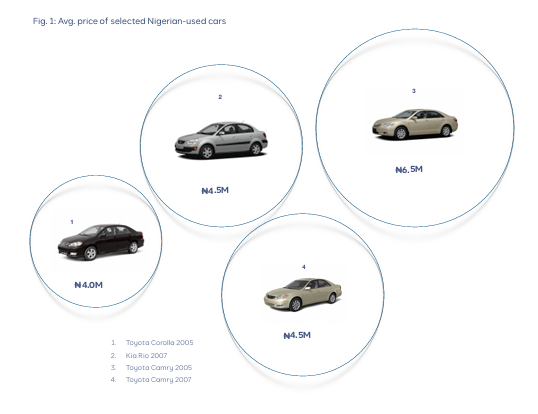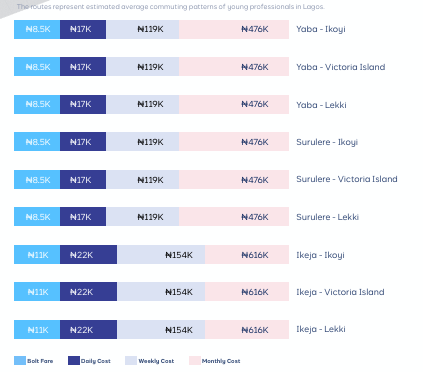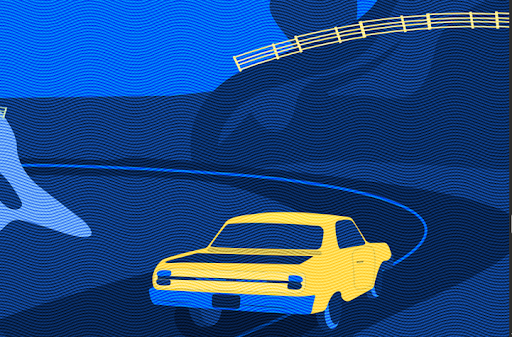Every Lagos professional faces the same dilemma: save money on transport and waste hours in traffic, or pay premium prices for convenience. New Cowrywise data puts actual numbers to this trade-off, revealing monthly costs—we’re talking ₦82,000 versus ₦420,000 monthly.
Here’s what the numbers really mean for your wallet, and why your transport choice might be the difference between building wealth or staying broke in Lagos.
How much each transport option cost

The math on Lagos transport is brutal, and most people don’t realise how much they’re really spending until they sit down and calculate it properly.
- Public transport from Yaba to Victoria Island costs about ₦82,000 monthly if you’re consistent with BRT and danfo. By year five, you’re looking at ₦1.4 million annually. It’s the cheapest option but comes with the usual Lagos public transport challenges – delays, overcrowding, and the occasional safety concern.
- Bolt and Uber for the same route will set you back ₦420,000 monthly. That’s over ₦5 million yearly, and here’s the kicker—these costs aren’t static. With ride-hailing prices increasing by about 12% annually, you’re looking at ₦8.7 million by year five. Most people using Bolt regularly have no idea they’re spending this much.
- Car ownership seems like the middle ground until you see the real numbers. A Toyota Corolla costs ₦18.9 million over five years even after you sell it. But in the real sense of things, you need to earn at least ₦1.2 million monthly to comfortably afford a car without it destroying your budget.
Why Bolt became so expensive

Remember when Bolt trips cost ₦8,000 for a decent ride across town? Those days are over.
Between early 2024 and October, fares jumped 50%. That same trip now costs ₦12,000 to ₦15,000, and during peak hours with surge pricing, you might even pay double.
The increase wasn’t gradual either. Users started noticing the jumps around March 2024, and by October, what used to be a ₦10,000 trip was consistently hitting ₦15,000.
If you’re using Bolt twice daily for work, you’re spending ₦30,000 daily just on commuting. Most professionals don’t have the time to track this properly and get shocked when they finally add up their monthly transport spending.
The ride-hailing companies are still working toward profitability, which means more price increases are coming. The CowryWise data shows a 12% compound annual growth rate, so expect your transport costs to keep climbing if you’re heavily dependent on these apps.
Is BRT cheaper than Danfo?
BRT fares range from ₦300 for short routes to ₦800 for longer distances. Even the most expensive BRT trip costs less than what you’d spend on a single Bolt ride. From Oshodi to CMS, BRT charges ₦400 while a private bus charges up to ₦1,000. Compare that to Bolt’s ₦15,000 for a similar distance, and you understand why the savings add up so quickly.
Danfo remains the cheapest option at ₦200-500 per trip, but it’s also the least predictable for many reasons. Prices could spike depending on several factors like rain for instance. You might wait 30 minutes for a bus, or get stuck in traffic for two hours. The trade-off is real—you save money but lose time and comfort.
What most people don’t factor in is that BRT has become more reliable over the past year. The government reduced fares by 30% on some routes and expanded coverage. If you live and work along BRT corridors, the service is actually decent now.
The car ownership reality check

Everyone thinks they can afford a car until they see the actual costs. To buy a Toyota Corolla in Lagos, you need to either save ₦415,000 monthly for a year, or ₦217,000 monthly for two years. Most people earning ₦600,000 monthly think saving ₦217,000 is manageable until they try living on ₦383,000 in Lagos.
The loan option looks attractive until you realize you’re paying ₦575,000 monthly. Add fuel costs of ₦300,000-500,000 monthly, insurance of ₦200,000-500,000 yearly, and regular maintenance, and you’re spending more than most people’s entire salary just on transport.
Car ownership only makes financial sense if you’re earning over ₦1.2 million monthly and can comfortably afford the total cost without it affecting your ability to save or invest.
What actually works by income level
The Cowrywise analysis breaks down transport affordability across different income brackets, revealing some stark realities about Lagos commuting patterns.
For professionals earning ₦200,000-500,000 monthly, the data shows that regular Bolt usage consumes 80-200% of their entire salary just for transport. The analysis found that workers in this bracket who rely heavily on ride-hailing often struggle to build savings, with transport costs crowding out other financial priorities.
The ₦500,000-1 million income range presents what the report calls a “false affordability trap.” While earning ₦700,000 monthly might seem sufficient for regular Bolt use, the analysis shows that spending ₦400,000 on transport leaves just ₦300,000 for all other expenses in Lagos. Most professionals in this bracket overestimate their transport budget capacity.
Only at income levels above ₦1 million monthly does car ownership become mathematically viable according to the data. Even then, the analysis notes that dedicating ₦5 million yearly to transport represents a significant opportunity cost for wealth building through investments or property acquisition.
The location strategy nobody talks about
The transport cost crisis is reshaping Lagos’s property market in ways most people are just starting to understand. Living in Yaba while working on the Island might seem like a budget-friendly choice, but spending ₦420,000 monthly on Bolt to get to work actually costs more than the housing savings.
This realisation is driving up property prices in areas with shorter commutes or better BRT access. Everyone’s doing the same math; pay more upfront to live closer to work, or watch transport costs eat up the savings. The result is increased demand for housing near business districts and along major transport corridors.
Property developers and landlords have caught on too. Areas that were previously considered “inconvenient” but had good transport links are seeing rapid price increases as professionals prioritize commute costs over traditional location preferences. It’s become common knowledge among young professionals that your housing choice directly impacts your transport budget, and vice versa.
What’s next for Lagos?
The government is expanding BRT routes and building new rail lines, with recent BRT fare reductions and new regulations targeting ride-hailing commission rates. But these improvements take years while transport costs keep rising today, making it impractical to base current financial decisions on promised future changes.
The Cowrywise data makes one thing clear: your transport choice in Lagos isn’t just about daily comfort – it’s about long-term wealth building. Spending ₦420,000 monthly on Bolt means ₦5 million yearly that could go toward savings, investments, or property down payments. Public transport costs five times less than ride-hailing, but the real question is whether the time and convenience trade-offs justify the financial impact.
For most Lagos professionals earning under ₦800,000 monthly, the analysis suggests heavy Bolt usage represents a significant financial opportunity cost. The money saved using BRT could fund emergency savings or investments that build wealth over time. The professionals who thrive in Lagos long-term often master this transport equation early, making choices that compound into serious financial advantages.
Get passive updates on African tech & startups
View and choose the stories to interact with on our WhatsApp Channel
Explore




